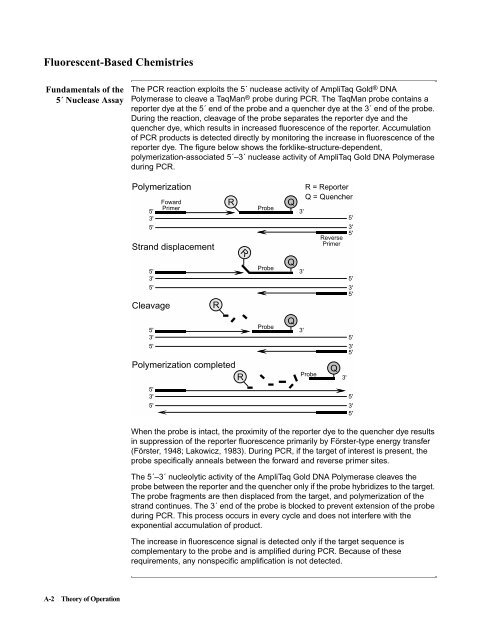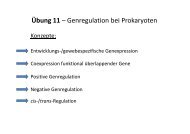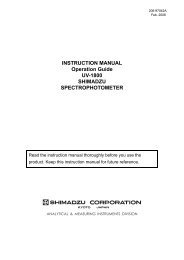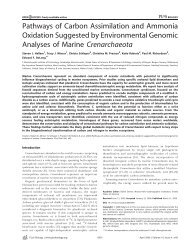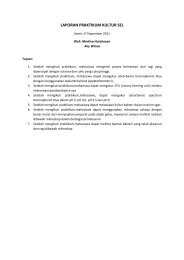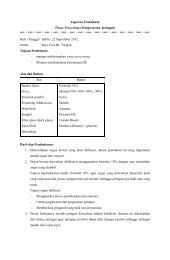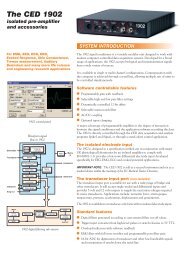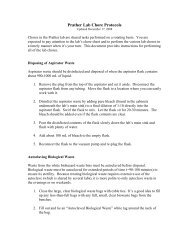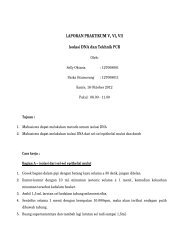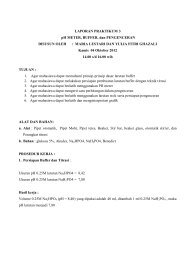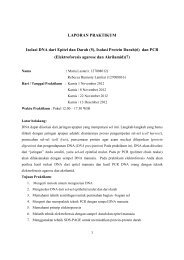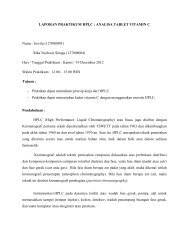ABI Prism® 7900HT Sequence Detection System ... - OpenWetWare
ABI Prism® 7900HT Sequence Detection System ... - OpenWetWare
ABI Prism® 7900HT Sequence Detection System ... - OpenWetWare
You also want an ePaper? Increase the reach of your titles
YUMPU automatically turns print PDFs into web optimized ePapers that Google loves.
Fluorescent-Based Chemistries<br />
Fundamentals of the<br />
5´ Nuclease Assay<br />
A-2 Theory of Operation<br />
The PCR reaction exploits the 5´ nuclease activity of AmpliTaq Gold ® DNA<br />
Polymerase to cleave a TaqMan ® probe during PCR. The TaqMan probe contains a<br />
reporter dye at the 5´ end of the probe and a quencher dye at the 3´ end of the probe.<br />
During the reaction, cleavage of the probe separates the reporter dye and the<br />
quencher dye, which results in increased fluorescence of the reporter. Accumulation<br />
of PCR products is detected directly by monitoring the increase in fluorescence of the<br />
reporter dye. The figure below shows the forklike-structure-dependent,<br />
polymerization-associated 5´–3´ nuclease activity of AmpliTaq Gold DNA Polymerase<br />
during PCR.<br />
Polymerization<br />
5'<br />
3'<br />
5'<br />
Foward<br />
Primer<br />
Strand displacement<br />
R<br />
R<br />
R<br />
Probe<br />
When the probe is intact, the proximity of the reporter dye to the quencher dye results<br />
in suppression of the reporter fluorescence primarily by Förster-type energy transfer<br />
(Förster, 1948; Lakowicz, 1983). During PCR, if the target of interest is present, the<br />
probe specifically anneals between the forward and reverse primer sites.<br />
The 5´–3´ nucleolytic activity of the AmpliTaq Gold DNA Polymerase cleaves the<br />
probe between the reporter and the quencher only if the probe hybridizes to the target.<br />
The probe fragments are then displaced from the target, and polymerization of the<br />
strand continues. The 3´ end of the probe is blocked to prevent extension of the probe<br />
during PCR. This process occurs in every cycle and does not interfere with the<br />
exponential accumulation of product.<br />
The increase in fluorescence signal is detected only if the target sequence is<br />
complementary to the probe and is amplified during PCR. Because of these<br />
requirements, any nonspecific amplification is not detected.<br />
Q<br />
3'<br />
R = Reporter<br />
Q = Quencher<br />
Reverse<br />
Primer<br />
5'<br />
Probe<br />
3'<br />
3'<br />
5'<br />
5' 3'<br />
5'<br />
Cleavage<br />
5'<br />
Probe<br />
3'<br />
3'<br />
5'<br />
5' 3'<br />
5'<br />
Polymerization completed Q<br />
Probe<br />
R<br />
5'<br />
3'<br />
5'<br />
5' 3'<br />
5'<br />
Q<br />
Q<br />
3'<br />
5'<br />
3'<br />
5'


